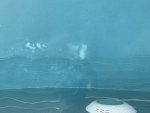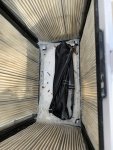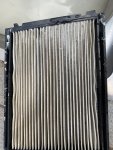I’m having issues with what I think is calcium deposits, they are found on the bottom of the pool below the returns and on one of the steps. See photo

After running the dolphin robot it’s filter was full of what I think is calcium deposits


The pool is a 2 month old beadcrete in-ground pool where the steps and bench are genuine marble.
I use a SWG for chlorination and an automatic acid feeder to keep pH balanced, the pH feeder is controlled by a pH probe in the pipe after the filter. The installer provided the initial liquid acid, 40% sulfuric acid, notice not muriatic acid, is that an issue?
Measurement data from today:
FC 9.5 target 7
CC 0.5
pH 7.4
TA 110
CH 400-425
CYA 90
SALT 4000
TEMP 32 Celsius / 89 Fahrenheit
PoolMath app reports CSI -0.11 with the above, so if anything I should have issues with dissolving calcium from the beadcrete plaster and marble steps.
In addition to the calcium deposits I also noticed that pH is drifting upwards. The automatic acid dosage system have added 1.5-2 litres of 40% sulfuric acid the past 12 days.
If I lower TA to 80 as recommended PoolMath says my CSI becomes -0.30, if I also raise pH to 7.6 it becomes -0.12
What do you recommend, lower TA to 80 by aeration and then raise pH to 7.6 ? Any other ideas?

After running the dolphin robot it’s filter was full of what I think is calcium deposits


The pool is a 2 month old beadcrete in-ground pool where the steps and bench are genuine marble.
I use a SWG for chlorination and an automatic acid feeder to keep pH balanced, the pH feeder is controlled by a pH probe in the pipe after the filter. The installer provided the initial liquid acid, 40% sulfuric acid, notice not muriatic acid, is that an issue?
Measurement data from today:
FC 9.5 target 7
CC 0.5
pH 7.4
TA 110
CH 400-425
CYA 90
SALT 4000
TEMP 32 Celsius / 89 Fahrenheit
PoolMath app reports CSI -0.11 with the above, so if anything I should have issues with dissolving calcium from the beadcrete plaster and marble steps.
In addition to the calcium deposits I also noticed that pH is drifting upwards. The automatic acid dosage system have added 1.5-2 litres of 40% sulfuric acid the past 12 days.
If I lower TA to 80 as recommended PoolMath says my CSI becomes -0.30, if I also raise pH to 7.6 it becomes -0.12
What do you recommend, lower TA to 80 by aeration and then raise pH to 7.6 ? Any other ideas?
Last edited:


